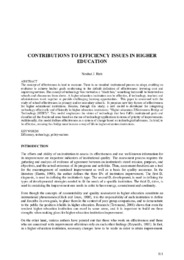Contributions to efficiency issues in higher Education
Abstract
The concept of effectiveness is hard to measure. There is no standard institutional process to adopt, enabling an evaluator to achieve his/her goals conforming to the default definition of effectiveness: lowering cost and improving services. The concept of technology was viewed as a "black box," something that could be bestowed on schools and classrooms from above. A higher education institution can be effective, if technology, teachers and administrators work together to provide challenging learning opportunities. This paper is concerned with the study of school effectiveness in primary and/or secondary schools. It proposes new key factors of effectiveness for higher educational institutions. Besides, through this study, a new model is developed for integrating technology effectively and efficiently in higher education institutions: "Higher education Effectiveness Bridge of Technology (HEBT)". This model emphasizes the vision of technology that best fulfils institutional goals and classifies all the functional areas based on the use of technology applications in terms of priority of improvements. Additionally, this model defines effectiveness as a system of change based on technological advances. In brief, to be effective, crossing this bridge must become a way of life in higher education institutions.
